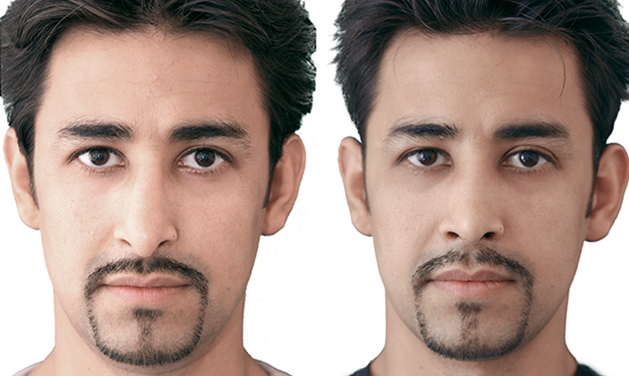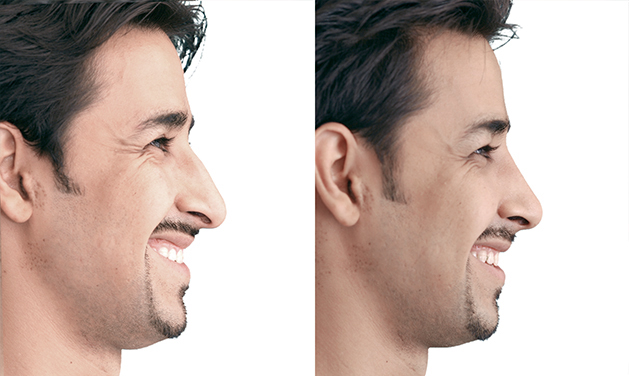Nasal Tip
Broad Nasal Tip
The shape and the position of the nasal tip play a major part in the character of the face. This young woman thought the tip of her nose was too wide and too long. During the procedure, I therefore narrowed the nasal tip, set it back and adjusted the nasal pyramid accordingly. The face now appears more balanced and softer. The After pictures were taken 6 months after the nose operation. 1-year and 5-year pictures followed after the corresponding time.

When the patient turns her head further, the change in shape and the setting-back of the nasal tip become evident, which makes the whole face of the young woman appear more harmonious. The incision through the nasal columella, which was necessary for the nose operation, is evident in the after picture.

Before the operation, the wide nasal tip and the curvature of the nasal pyramid are evident in the front view. The nasal columella is bend due to a significant torsion in the nasal septum inside the nose. The serious obstruction to the patient's nasal breathing could be easily fixed by the operation.

When the patient lowers her head, the change to the nasal tip is very evident. The restoration of the nasal tip caused the nasal wing to broaden slightly. The client did not want the nasal wing to be reduced with plastic surgery.

The different position of the nasal tip before and after the operation is evident in the side view. The patient's facial features were softened by setting back the nasal tip.

When people laugh, in many cases, the muscle tension in the upper lip causes the nasal tip to drop. As a result, the nose seems larger when the patient laughs. This muscle tension could be solved as a result of the nose operation.

The view of the nose from below clearly shows how the deviation in the nasal septum has shifted the nasal columella. In the past, when the patient breathed in, her left nostril closed. By straightening the nasal septum, the lower part of the nose became almost symmetrical, which alleviated the obstructed nasal breathing.

Broad nasal tip with hooked nose
This young man had an uncomfortably wide nasal tip, which was further emphasised by a narrow nasal pyramid. In the side profile, his hooked nose was also clearly visible.

During the aesthetic correction, I reorganised the hook on the nasal tip. Thus, I not only successfully achieved a more harmoniously structured nose shape but also optimised the patient's nasal breathing. The picture was taken 1 year after the operation.

In this view, the nasal humps are easily visible – on one hand, on the connection between the bony and the cartilaginous nasal pyramid; and on the other, above the nasal tip. I straightened the nasal pyramid and also harmonised the position of the nasal tip.

By lowering and straightening the nasal pyramid, the face obtains a more delicate radiance.

During the procedure, I designed the nasal pyramid to be slightly wider; in contrast, I narrowed the nasal tip.

Overall, by straightening the nasal pyramid, narrowing and raising the nasal tip, the lines and contours of the face become softer and more harmonious.
Wide nasal tip with asymmetrical nostrils
The young lady was uncomfortable with her prominent nasal tip. In addition, the bent nasal septum had obstructed her right nostril.

During the procedure, I was able to lower the tip of the nose and adjust the nasal pyramid accordingly.

The deviated nasal septum not only obstructed the patient's nasal breathing but also led to an incline in the nasal tip and in both nostrils.

I also pulled the raised nasal columella down during the surgery.

After the operation, the patient could once again breathe freely through her nose.
Drooping Nasal Tip 1
The position of the nasal tip is just as important for the harmony of the nose shape as it is for healthy nasal breathing. A drooping tip of the nose can have a significant effect on the flow of breath through your nose. Years ago, another surgeon performed a rhinoplasty procedure on this patient to improve his nasal breathing. However, the procedure did not lead to the desired success as the drooping nasal tip was not corrected.

I raised the nasal tip using tissue from the patient's own body, and straightened the nasal pyramid. In this way, I was able to widen the entrance to the nostril and thus improve his nasal breathing. The After pictures were taken 8 months after the operation.
Besides improving the patient's nasal breathing, his nose appeared significantly slimmer.

By raising the tip of the nose, the nose lookes more elegant when viewed from the front.


Drooping nasal tip 2
This man was uncomfortable with the downward inclination of the tip of his nose. It particularly irritated him that it dropped even further when he laughed.

I raised the nasal tip. The nasal columella now flows over into the nasal wing in a smooth, curved line. All the steps of this procedure were carried out inside the nose.

Split Nasal Tip 1
This gentleman had fallen and injured his nose in the process. The nasal injury could not be properly dealt with after the accident. This resulted in a noticeable and bothersome indentation in the area of the nasal tip, the nostrils and the nasal pyramid.

During the operation, I was able to reconstruct the cartilage of the nasal tip and thus corrected the pulling and the scar.


Drooping Nasal Columella
In addition to having difficulty breathing through her nose, the patient was unsatisfied with its shape. In specialist terms, this is referred to as a drooping nasal columella. On top of this, the nasal tip was wide and high, which also impacted the nasal pyramid.

During the nose operation, I had to make an incision through the nasal columella. The scar in the pictures is still evident, but it will become almost invisible with time.

Reducing the size of the nose immediately lends the face a more delicate, feminine appearance.

When the patient laughed, the nasal tip dropped further, which made her nose seem even larger. I was able to correct this during the nose operation.

Not only the tip of the nose but also the nasal columella and the nasal septum were too wide. I was able to address all these irregularities in a targeted manner without changing the overall frontal picture of the patient's face.

